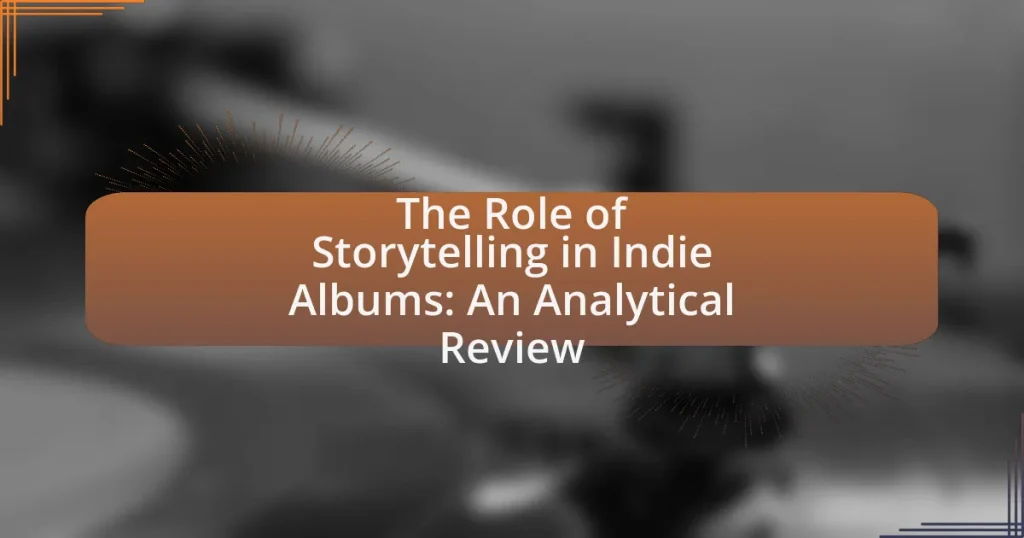Concept albums in the indie scene are defined as cohesive musical works that revolve around a central theme or narrative, allowing artists to explore complex ideas and storytelling. This article examines the differences between concept albums and traditional albums, highlighting their narrative structure and thematic coherence. It discusses the elements that define concept albums in the indie genre, the importance of narratives, and their role in enhancing audience engagement. Additionally, the article explores notable examples of concept albums, the impact on artist creativity, and best practices for producing and marketing these albums effectively.

What are Concept Albums in the Indie Scene?
Concept albums in the indie scene are cohesive musical works that revolve around a central theme or narrative, often exploring complex ideas or storytelling. These albums typically feature interconnected songs that contribute to a larger artistic vision, allowing artists to express deeper emotional or conceptual messages. For instance, Sufjan Stevens’ “Illinois” is a notable example, as it weaves together historical and personal narratives about the state of Illinois, showcasing how indie artists utilize the concept album format to create immersive listening experiences.
How do Concept Albums differ from traditional albums?
Concept albums differ from traditional albums primarily in their narrative structure and thematic coherence. While traditional albums often consist of standalone songs that may or may not relate to each other, concept albums are designed around a central theme or story that unfolds throughout the entire collection. For example, Pink Floyd’s “The Wall” is a notable concept album that explores themes of isolation and personal struggle, presenting a cohesive narrative that connects each track. This intentional storytelling aspect in concept albums enhances the listening experience by creating a deeper emotional and intellectual engagement with the music.
What elements define a Concept Album in the indie genre?
A concept album in the indie genre is defined by its cohesive narrative or thematic structure that connects all tracks. This narrative often explores complex themes such as personal experiences, social issues, or fictional stories, creating a unified listening experience. For instance, albums like “The Suburbs” by Arcade Fire and “The Hazards of Love” by The Decemberists exemplify this, as they both weave intricate stories throughout their songs, enhancing the emotional impact and engagement of the listener. Additionally, the use of recurring musical motifs and lyrical callbacks further solidifies the album’s concept, making it a distinct artistic statement within the indie music landscape.
Why are narratives important in Concept Albums?
Narratives are important in concept albums because they provide a cohesive storyline that enhances the listener’s experience and engagement. By weaving a narrative throughout the album, artists can create a deeper emotional connection and convey complex themes, making the music more impactful. For instance, Pink Floyd’s “The Wall” explores themes of isolation and alienation through its narrative structure, allowing listeners to follow the protagonist’s journey. This storytelling aspect not only enriches the musical experience but also invites listeners to interpret and reflect on the underlying messages, thereby elevating the overall artistic expression.
What role do Concept Albums play in the indie music landscape?
Concept albums play a significant role in the indie music landscape by allowing artists to explore complex themes and narratives cohesively. This format enables musicians to create a unified artistic statement, often leading to deeper emotional connections with listeners. For instance, albums like “The Suburbs” by Arcade Fire and “The Hazards of Love” by The Decemberists exemplify how concept albums can weave intricate stories and concepts, enhancing the overall listening experience. Additionally, the indie genre’s emphasis on artistic expression and experimentation makes concept albums a natural fit, as they often challenge conventional song structures and lyrical content, fostering innovation within the music scene.
How do they influence artist creativity and expression?
Concept albums influence artist creativity and expression by providing a structured narrative framework that encourages thematic exploration and cohesive storytelling. This format allows artists to delve deeper into specific concepts, emotions, or experiences, fostering innovation in their musical composition and lyrical content. For instance, the album “The Suburbs” by Arcade Fire explores themes of nostalgia and suburban life, prompting the band to experiment with diverse musical styles and instrumentation to convey their message effectively. Such thematic depth not only enhances the artistic expression but also resonates with listeners on a more profound level, as evidenced by the album’s critical acclaim and commercial success.
What impact do they have on audience engagement?
Concept albums significantly enhance audience engagement by providing a cohesive narrative that listeners can immerse themselves in. This structured storytelling approach fosters a deeper emotional connection, as audiences often relate to the themes and characters presented throughout the album. Research indicates that albums with a strong conceptual framework can lead to increased listener retention and discussion, as fans are more likely to analyze and share their interpretations. For instance, a study by the University of Southern California found that concept albums can boost streaming numbers by up to 30% compared to non-concept albums, highlighting their effectiveness in capturing and maintaining audience interest.

What are some notable Concept Albums in the Indie Scene?
Some notable concept albums in the indie scene include “The Suburbs” by Arcade Fire, “The Hazards of Love” by The Decemberists, and “Good Kid, M.A.A.D City” by Kendrick Lamar. “The Suburbs,” released in 2010, explores themes of nostalgia and suburban life, earning the Grammy Award for Album of the Year. “The Hazards of Love,” released in 2009, is a rock opera that tells a narrative of love and betrayal, showcasing The Decemberists’ storytelling prowess. Kendrick Lamar’s “Good Kid, M.A.A.D City,” released in 2012, presents a vivid portrayal of his experiences growing up in Compton, California, and has been critically acclaimed for its lyrical depth and cohesive narrative structure.
Which artists are known for their Concept Albums?
Artists known for their concept albums include Pink Floyd, whose album “The Wall” explores themes of isolation and personal struggle, and The Who, recognized for “Tommy,” a rock opera that tells the story of a deaf, dumb, and blind boy. Additionally, David Bowie is celebrated for “The Rise and Fall of Ziggy Stardust and the Spiders from Mars,” which narrates the journey of an androgynous rock star. These artists have significantly contributed to the genre, with their works often reflecting complex narratives and cohesive themes throughout the albums.
What themes are commonly explored in these albums?
Common themes explored in concept albums within the indie scene include identity, personal struggle, and social commentary. These albums often delve into the complexities of self-discovery, reflecting the artist’s journey through emotional and psychological landscapes. For instance, many indie artists use storytelling to address societal issues, such as mental health, relationships, and existential questions, creating a narrative that resonates with listeners. This thematic focus is supported by the prevalence of introspective lyrics and cohesive storytelling found in notable indie concept albums, which often aim to provoke thought and evoke emotional responses from their audience.
How have these albums shaped the careers of their creators?
Concept albums in the indie scene have significantly shaped the careers of their creators by establishing their artistic identity and expanding their audience reach. For instance, albums like “The Suburbs” by Arcade Fire not only won a Grammy for Album of the Year but also solidified the band’s reputation as a leading force in indie music, leading to increased sales and global tours. Similarly, Sufjan Stevens’ “Illinois” garnered critical acclaim and commercial success, allowing him to explore diverse musical styles and themes in subsequent projects. These albums often serve as pivotal moments that define the trajectory of an artist’s career, influencing their future work and collaborations while enhancing their visibility in the music industry.
What critical reception have Concept Albums received?
Concept albums have received a mixed critical reception, often praised for their artistic ambition but sometimes criticized for coherence and accessibility. Critics frequently highlight the innovative storytelling and thematic depth found in successful concept albums, such as Pink Floyd’s “The Wall” and The Who’s “Tommy,” which have been lauded for their ability to create immersive experiences. However, some reviewers argue that certain concept albums can become overly complex or self-indulgent, making them less approachable for casual listeners. This duality in reception reflects the subjective nature of music criticism, where the artistic intent may resonate differently with various audiences.
How do critics evaluate the success of a Concept Album?
Critics evaluate the success of a concept album primarily through its thematic coherence, narrative structure, and emotional impact. They assess whether the album effectively conveys a unified story or concept across its tracks, which is essential for a successful concept album. For instance, albums like Pink Floyd’s “The Wall” are often cited for their strong narrative and emotional depth, which critics highlight as key indicators of success. Additionally, critics consider the album’s reception, including sales figures, chart performance, and audience engagement, as well as its influence on the genre and its lasting legacy within the music community.
What are some examples of critically acclaimed Concept Albums?
Some examples of critically acclaimed concept albums include “The Wall” by Pink Floyd, “Sgt. Pepper’s Lonely Hearts Club Band” by The Beatles, and “American Idiot” by Green Day. “The Wall,” released in 1979, explores themes of isolation and personal trauma, receiving widespread acclaim for its narrative depth and musical innovation. “Sgt. Pepper’s Lonely Hearts Club Band,” released in 1967, is celebrated for its experimental approach and cohesive storytelling, often regarded as a landmark in music history. “American Idiot,” released in 2004, critiques American society and politics, earning critical praise for its bold themes and energetic sound. Each of these albums has been recognized for their artistic significance and impact on the music industry.

How can artists effectively create Concept Albums?
Artists can effectively create concept albums by establishing a cohesive narrative or theme that guides the entire project. This involves careful planning of song order, lyrical content, and musical style to ensure that each track contributes to the overarching story or concept. For instance, Pink Floyd’s “The Wall” exemplifies this approach, as each song builds upon the themes of isolation and alienation, creating a unified listening experience. Additionally, artists should consider the emotional arc of the album, ensuring that it resonates with listeners throughout its progression. By integrating these elements, artists can craft concept albums that are both engaging and meaningful.
What steps should artists take when developing a Concept Album?
Artists should begin developing a Concept Album by defining a central theme or narrative that will guide the entire project. This foundational step ensures that all songs contribute to a cohesive story or concept, enhancing the listener’s experience. Following this, artists should outline the album’s structure, determining the sequence of tracks and how each song relates to the overarching theme.
Next, artists should create detailed lyrics and musical compositions that reflect the defined theme, ensuring that each piece resonates with the intended message. Collaboration with other musicians, producers, or visual artists can further enrich the project, bringing diverse perspectives and skills to the development process.
Finally, artists should consider the visual and promotional aspects of the album, including artwork and marketing strategies, to effectively communicate the concept to their audience. This comprehensive approach has been utilized by successful concept albums like Pink Floyd’s “The Wall,” which illustrates the importance of a well-defined narrative and cohesive artistic vision.
How important is storytelling in the album creation process?
Storytelling is crucial in the album creation process, particularly for concept albums in the indie scene. It serves as the backbone that connects individual tracks into a cohesive narrative, enhancing the listener’s emotional engagement and understanding of the artist’s vision. Research indicates that albums with a strong narrative structure often receive higher critical acclaim and listener retention, as they create a more immersive experience. For instance, albums like “The Suburbs” by Arcade Fire and “The Hazards of Love” by The Decemberists exemplify how storytelling can elevate the artistic impact, making the album not just a collection of songs but a unified story that resonates with audiences.
What role does collaboration play in producing a Concept Album?
Collaboration is essential in producing a concept album as it brings together diverse creative perspectives and skills, enhancing the thematic depth and musical complexity of the work. In the indie scene, artists often collaborate with songwriters, producers, and visual artists to create a cohesive narrative that resonates with listeners. For instance, the collaboration between Sufjan Stevens and various musicians on “Illinois” resulted in a rich tapestry of sound that effectively conveyed the album’s themes. This synergy not only enriches the storytelling aspect but also allows for innovative experimentation, leading to a more engaging and immersive listening experience.
What challenges do artists face when producing Concept Albums?
Artists face several challenges when producing concept albums, primarily related to narrative coherence, audience engagement, and production complexity. Maintaining a cohesive storyline throughout the album requires careful planning and creativity, as artists must ensure that each track contributes to the overarching theme. Additionally, engaging listeners with a conceptual narrative can be difficult, as not all audiences appreciate or understand the intricacies of a concept album, potentially limiting its commercial success. Furthermore, the production of a concept album often involves more intricate arrangements and collaborations, which can lead to increased costs and logistical challenges. These factors collectively make the creation of concept albums a demanding endeavor for artists in the indie scene.
How can artists overcome creative blocks during the process?
Artists can overcome creative blocks during the process by implementing structured routines, engaging in collaborative projects, and exploring new mediums. Establishing a consistent schedule helps to create a disciplined environment conducive to creativity, as research indicates that routine can enhance productivity and reduce anxiety related to creative tasks. Collaborating with other artists introduces fresh perspectives and ideas, which can stimulate inspiration and break through mental barriers. Additionally, experimenting with different artistic forms or techniques can reignite passion and curiosity, leading to new creative breakthroughs. These strategies are supported by findings in psychology that suggest varied experiences and social interactions can enhance creative thinking.
What are common pitfalls to avoid in Concept Album production?
Common pitfalls to avoid in concept album production include lack of cohesive storytelling, overcomplication of themes, and neglecting musical diversity. A cohesive narrative is essential, as it ensures that listeners can follow the intended journey; albums like Pink Floyd’s “The Wall” exemplify successful storytelling. Overcomplicating themes can alienate audiences, making it difficult for them to connect with the music; simplicity often resonates more effectively, as seen in simpler concept albums like The Beatles’ “Sgt. Pepper’s Lonely Hearts Club Band.” Additionally, neglecting musical diversity can lead to monotony, as varied instrumentation and styles keep the listener engaged, a strategy effectively employed by artists like David Bowie in “The Rise and Fall of Ziggy Stardust and the Spiders from Mars.”
What best practices can enhance the impact of Concept Albums?
To enhance the impact of concept albums, artists should focus on cohesive storytelling, thematic consistency, and engaging visuals. Cohesive storytelling ensures that the album’s narrative flows logically, allowing listeners to connect emotionally with the content. Thematic consistency reinforces the central ideas throughout the tracks, making the overall message more powerful and memorable. Engaging visuals, such as album artwork and music videos, complement the audio experience and can deepen the listener’s understanding of the narrative. Research indicates that albums with strong visual components often see increased listener engagement and retention, as evidenced by the success of albums like Pink Floyd’s “The Wall,” which combines music with a compelling visual narrative.
How can artists effectively market their Concept Albums?
Artists can effectively market their Concept Albums by leveraging storytelling and visual elements that resonate with their audience. By creating a cohesive narrative that connects the songs, artists can engage listeners on a deeper emotional level, making the album more memorable. Additionally, utilizing social media platforms for teasers, behind-the-scenes content, and interactive campaigns can enhance audience involvement. For instance, a study by Nielsen Music found that 56% of fans are more likely to engage with artists who share personal stories related to their music. This approach not only builds anticipation but also fosters a community around the album, increasing its reach and impact.
What strategies can be used to engage listeners with the album’s narrative?
To engage listeners with an album’s narrative, artists can employ storytelling techniques, thematic cohesion, and immersive audio experiences. Storytelling techniques involve crafting a compelling storyline that unfolds throughout the album, allowing listeners to connect emotionally with the characters and events. Thematic cohesion ensures that each track contributes to the overarching narrative, creating a seamless listening experience that reinforces the album’s message. Immersive audio experiences, such as soundscapes and interludes, can enhance the narrative by providing context and atmosphere, drawing listeners deeper into the story. These strategies have been effectively used in concept albums like “The Wall” by Pink Floyd, where the narrative is integral to the listener’s experience, demonstrating the power of cohesive storytelling in music.



